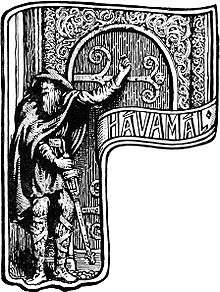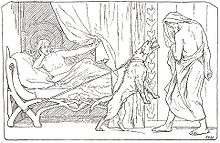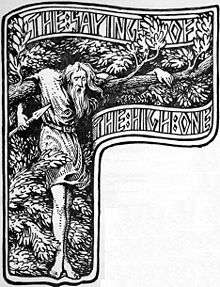Hávamál
Hávamál (English: /ˈhɔːvəˌmɔːl/ HAW-və-mawl; Old Norse: Hávamál,[note 1] classical pron. [ˈhɒːβaˌmɒːl], Modern Icelandic pron. [ˈhauvaˌmaul̥], ‘Words of Hávi [the High One]’) is presented as a single poem in the Codex Regius, a collection of Old Norse poems from the Viking age. The poem, itself a combination of numerous shorter poems, is largely gnomic, presenting advice for living, proper conduct and wisdom. It is our most important source on Old Norse philosophy.

The verses are attributed to Odin; the implicit attribution to Odin facilitated the accretion of various mythological material also dealing with the same deity.[1]
For the most part composed in the metre ljóðaháttr, a metre associated with wisdom verse, Hávamál is both practical and philosophical in content.[2] Following the gnomic "Hávamál proper" comes the Rúnatal, an account of how Odin won the runes, and the Ljóðatal, a list of magic chants or spells.[3]
Name
The Old Norse name Hávamál is a compound of the genitive form of Hávi, which is the inflexionally weak form of Odin's name Hár ('High One'), and the plural noun mál (from older mǫ́l), and means 'Song (or Words) of the High One'.[4][5]
Textual history
The only surviving source for Hávamál is the 13th century Codex Regius, with the exception of two short parts.[note 2] The part dealing with ethical conduct (the Gestaþáttr) was traditionally identified as the oldest portion of the poem by scholarship in the 19th and early 20th century. Bellows (1936) identifies as the core of the poem a "collection of proverbs and wise counsels" which dates to "a very early time", but which, by the nature of oral tradition, never had a fixed form or extent. Von See (1981) identifies direct influence of the Disticha Catonis on the Gestaþáttr, suggesting that also this part is a product of the high medieval period and casting doubt on the "unadulterated Germanic character" of the poem claimed by earlier commentators.[6]
To the gnomic core of the poem, other fragments and poems dealing with wisdom and proverbs accreted over time. A discussion of authorship or date for the individual parts would be futile, since almost every line or stanza could have been added, altered or removed at will at any time before the poem was written down in the 13th century. Individual verses or stanzas nevertheless certainly date to as early as the 10th, or even the 9th century. Thus, the line deyr fé, deyja frændr ("cattle die, kinsmen die") found in verses 76 and 77 of the Gestaþáttr can be shown to date to the 10th century, as it also occurs in the Hákonarmál by Eyvindr skáldaspillir.
Structure
The Hávamál is edited in 165 stanzas by Bellows (1936). Other editions give 164 stanzas, combining Bellow's stanzas 11 and 12, as the manuscript abbreviates the last two lines of stanzas 11. Some editors also combine Bellow's stanzas 163 and 164. In the following, Bellow's numeration is used.
The poems in Hávamál is traditionally taken to consist of at least five independent parts,
- the Gestaþáttr, or Hávamál proper, (stanzas 1–80), a collection of proverbs and gnomic wisdom
- a dissertation on the faithlessness of women (stanzas 81–95), prefacing an account of the love-story of Odin and the daughter of Billingr (stanzas 96–102) and the story of how Odin got the mead of poetry from the maiden Gunnlöð (stanzas 103–110)
- the Loddfáfnismál (stanzas 111–138), a collection of gnomic verses similar to the Gestaþáttr, addressed to a certain Loddfáfnir
- the Rúnatal (stanzas 139–146), an account of how Odin won the runes, introductory to the Ljóðatal
- the Ljóðatal (stanzas 147–165), a collection of charms
Stanzas 6 and 27 are expanded beyond the standard four lines by an additional two lines of "commentary". Bellow's edition inverses the manuscript order of stanzas 39 and 40. Bellow's stanza 138 (Ljóðalok) is taken from the very end of the poem in the manuscript, placed before the Rúnatal by most editors following Müllenhoff. Stanzas 65, 73–74, 79, 111, 133–134, 163 are defective.
Stanzas 81–84 are in málaháttr, 85–88 in fornyrðislag. The entire section of 81–102 appears to be an ad hoc interpolation. Stanza 145 is also an interpolation in málaháttr.
Contents
Gestaþáttr
The first section Gestaþáttr, the "guest's section". Stanzas 1 through 79 comprise a set of maxims for how to handle oneself when a guest and traveling, focusing particularly on manners and other behavioral relationships between hosts and guests and the sacred lore of reciprocity and hospitality to the Norse pagans.
The first stanza exemplifies the practical behavioral advice it offers:
"Gattir allar,
aþr gangi fram,
vm scoðaz scyli,
vm scygnaz scyli;
þviat ouist er at vita,
hvar ovinir sitia
a fleti fyr."[note 3]
All the entrances, before you walk forward,
you should look at,
you should spy out;
for you can't know for certain where enemies are sitting,
ahead in the hall[3]
Number 77 is possibly the most known section of Gestaþáttr:
"Deyr fę,
deyia frǫndr,
deyr sialfr it sama;
ec veit einn
at aldri deýr:
domr vm dꜹþan hvern."
Cattle die,
friends die,
and the same with you;
but I know of something that never dies
and that's a dead person's deeds.[7]
On women

Stanzas 83 to 110 deal with the general topic of romantic love and the character of women.
It is introduced by a discussion of the faithlessness of women and advice for the seducing of them in stanzas 84–95, followed by two mythological accounts of Odin's interaction with women also known as "Odin's Examples" or "Odin's Love Quests". The first is an account of Odin's thwarted attempt of possessing the daughter of Billing (stanzas 96–102), followed by the story of the mead of poetry which Odin won by seducing its guardian, the maiden Gunnlöð (stanzas 103–110).
Loddfáfnismál
The Loddfáfnismál (stanzas 111–138) is again gnomic, dealing with morals, ethics, correct action and codes of conduct. The section is directed to Loddfáfnir ("stray-singer").
Rúnatal

Rúnatal or Óðins Rune Song, Rúnatáls-þáttr-Óðins (stanzas 139–146) is a section of the Hávamál where Odin reveals the origins of the runes. In stanzas 139 and 140, Odin describes his sacrifice of himself to himself:
"Vęit ec at ec hecc
vindga meiði a
nętr allar nío,
geiri vndaþr
oc gefinn Oðni,
sialfr sialfom mer,
a þeim meiþi,
er mangi veit,
hvers hann af rótom renn.
Við hleifi mic seldo
ne viþ hórnigi,
nysta ec niþr,
nam ec vp rv́nar,
ǫpandi nam,
fęll ec aptr þatan."
I know that I hung on a windy tree
nine long nights,
wounded with a spear, dedicated to Odin,
myself to myself,
on that tree of which no man knows from where its roots run.
No bread did they give me nor a drink from a horn,
downwards I peered;
I took up the runes,
screaming I took them,
then I fell back from there.[9]
The "windy tree" from which the victim hangs is often identified with the world tree Yggdrasil by commentators. The entire scene, the sacrifice of a god to himself, the execution method by hanging the victim on a tree, and the wound inflicted on the victim by a spear, is often compared to the crucifixion of Christ as narrated in the gospels.
The parallelism of Odin and Christ during the period of open co-existence of Christianity and Norse paganism in Scandinavia (the 9th to 12th centuries, corresponding with the assumed horizon of the poem's composition) is also evident from other sources. To what extent this parallelism is an incidental similarity of the mode of human sacrifice offered to Odin and the crucifixion, and to what extent a Pagan influence on Christianity, or vice versa, may have occurred, is a complex question on which scholarly opinions vary.[10]
Ljóðatal
The last section, the Ljóðatal enumerates eighteen songs (ljóð), sometimes called "charms", prefaced with (stanza 147):
"Lioþ ec þꜹ kann,
er kannat þioðans kóna
oc mannzcis mꜹgr"
The songs I know
that king's wives know not
Nor men that are sons of men.
The songs themselves are not given, just their application or effect described. They are explicitly counted from "the first" in stanza 147, and "a second" to "an eighteenth" in stanzas 148 to 165, given in Roman numerals in the manuscript.[11]
There is no explicit mention of runes or runic magic in the Ljóðatal excepting in the twelfth song (stanza 158), which takes up the motif of Odin hanging on the tree and its association with runes:
"sva ec rist
oc i rv́nom fác"
So do I write
and color the runes
Nevertheless, because of the Rúnatal preceding the list, modern commentators sometimes reinterpret the Ljóðatal as referring to runes, specifically with the sixteen letters of the Younger Futhark.
Müllenhoff takes the original Ljóðatal to have ended with stanza 161, with the final three songs (16th to 18th) taken as late and obscure additions.
Germanic Neopaganism
The difference of sixteen runes of the Younger Futhark vs. eighteen charms in the Ljóðatal has notably motivated proponents of Germanic mysticism to expand the row by two extra runes. The best-known attempt to this effect are the Armanen runes by Guido von List (1902).
Various proponents of Germanic Neopagan groups place an emphasis on Hávamál as a source of a Norse pagan ethical code of conduct. The "Nine Noble Virtues", first compiled by Odinic Rite founder John "Stubba" Yeowell in the 1970s are "loosely based" on the Hávamál. The Northvegr Foundation cites the Hávamál among other Old Norse and Old English sources to illustrate "the ethical ideal of the Northern spiritual faith of Heithni."[12]
Sveinbjörn Beinteinsson, leader of the Icelandic Ásatrúarfélagið, published his performance of a number of Eddaic poems, including the Hávamál, chanted in rímur style.[13]
Editions and translations
- editio princeps: Peder Hansen Resen, Edda. Islandorum an. Chr. 1215 islandice conscripta,1665 (Google Books).
- Peter Andreas Munch, Carl Rikard Unger, Den Ældre Edda: Samling af norrøne oldkvad, indeholdende Nordens ældste gude- og helte-sagn, Christiania: P. T. Malling, 1847 (Internet Archive)
- Benjamin Thorpe, Edda Sæmundar Hinns Froða: The Edda Of Sæmund The Learned, 1866 (online transcription).
- Sophus Bugge, Sæmundar Edda hins fróða. Christiania: P. T. Malling, 1867.
- Olive Bray, The Elder or Poetic Edda, commonly known as Sæmund's Edda, part I: The Mythological Poems, London: Printed for the Viking Club, 1908, pp. 61–111.
- H. A. Bellows, The Poetic Edda, 1936, "Hovamol: The Ballad of the High One" (online edition).
- Jackson Crawford, The Wanderer's Hávamál, 2019 (Google Books).
See also
Notes
- Unnormalised spelling in the Codex Regius:
Title: hava mal
Final stanza: Nv ero Hava mál qveðin Háva hꜹllo i [...] - The first stanza is also found in the manuscripts of the Prose Edda (in slightly different versions), and three lines of a later stanza are also found in the manuscripts of Fóstbrœðra saga (again in slightly different versions).
- Quoted after the Codex Regius.
References
- Bellows (1936), introductory note.
- Richardson, Nathaniel Smith; Boggs, Edward Brenton; Baum, Henry Mason (1872). The Church Review. Bassett and Bradley.
- Larrington, Carolyne. (Trans.) (1999) The Poetic Edda, p. 14. Oxford World's Classics ISBN 0-19-283946-2
- Orchard 1997, pp. 74–75.
- Lindow 2002, pp. 164, 212.
- Klaus von See: „Disticha Catonis und Hávamál.“ In: Klaus von See: Edda, Saga, Skaldendichtung. Heidelberg 1981, 27–44.
- Bellows, Henry Adams (2012). The Poetic Edda: The Heroic Poems. Dover Publications.
- c.f. Patton 2009:271.
- Larrington, Carolyne. (Trans.) (1999) The Poetic Edda, p. 34. Oxford World's Classics ISBN 0-19-283946-2
- a sketch of the problem is given by Kimberley Christine Patton, Religion of the gods: ritual, paradox, and reflexivity Oxford University, ISBN 978-0-19-509106-9, chapter 7 "Myself to Myself: The Norse Odin and Divine Autosacrifice".
- Bellows separates the "seventeenth" item into stanzas 163 and 164. There is a gap in stanza 163, and some editors have also combined 163 and 164 into a single stanza.
- Alfta Lothursdottir, Trulog and Sogumal, Northvegr (2006); Trúlög: Northern Truisms (northvegr.org)
- "Edda", Current 93 (1991); [citation needed]
Bibliography
- Lindow, John (2002). Norse Mythology: A Guide to Gods, Heroes, Rituals, and Beliefs. Oxford University Press. ISBN 978-0-19-983969-8.
- Orchard, Andy (1997). Dictionary of Norse Myth and Legend. Cassell. ISBN 978-0-304-34520-5.CS1 maint: ref=harv (link)
Further reading
- C. V. Müllenhoff, Deutsche Altertumskunde, Berlin (1891).
External links
| Wikisource has original text related to this article: |
![]()
- "Havamal – Translation by Benjamin Thorpe". Archived from the original on 2008-05-15.
- Hávamál Translation by W. H. Auden and P. B. Taylor
- Hávamál Translation by Olive Bray
- Hávamál Original text
- Parallel versions of Odin's "Rune Song" with the Bellows, Hollander, Larrington and Orchard translations
- Futhark Hávamál Select stanzas rendered in Elder Futhark and English